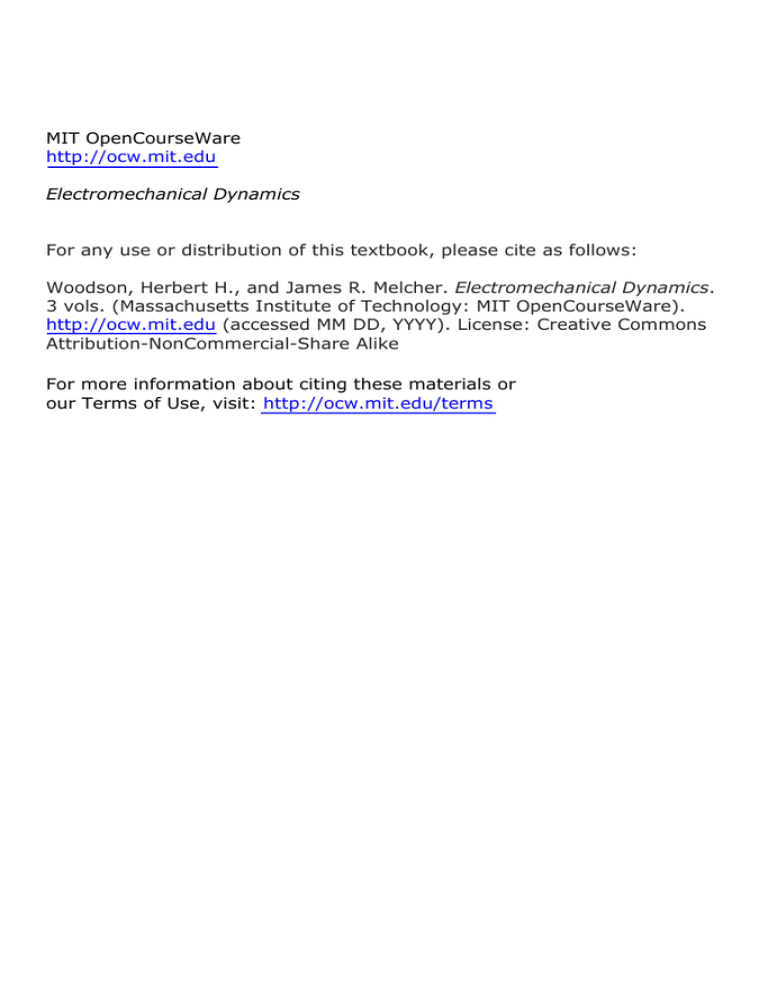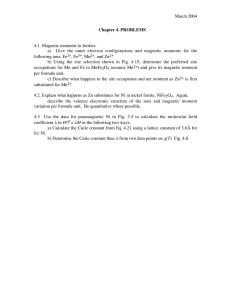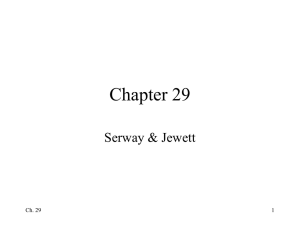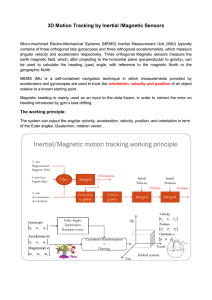MIT OpenCourseWare Electromechanical Dynamics
advertisement

MIT OpenCourseWare http://ocw.mit.edu Electromechanical Dynamics For any use or distribution of this textbook, please cite as follows: Woodson, Herbert H., and James R. Melcher. Electromechanical Dynamics. 3 vols. (Massachusetts Institute of Technology: MIT OpenCourseWare). http://ocw.mit.edu (accessed MM DD, YYYY). License: Creative Commons Attribution-NonCommercial-Share Alike For more information about citing these materials or our Terms of Use, visit: http://ocw.mit.edu/terms Problems are different; for example, the homopolar machine has essentially a one-turn armature and is always a low-voltage, high-current device. Thus matching a wire-wound coil to this low impedance is difficult and few homopolar machines can be self-excited, either with series field windings or with shunt field windings. Consequently, most homopolar machines have separately excited field windings. Because of the similarity between homopolar and commutator machine characteristics we terminate the discussion here and treat homopolar machines further in the problems at the end of this chapter. 6.5 DISCUSSION In this chapter we have made the necessary generalizations of electromagnetic theory that are needed for analyzing quasistatic systems with materials in relative motion. This has involved transformations for source and field quantities between inertial reference frames, boundary conditions for moving boundaries, and constituent relations for moving materials. In addition to some simple examples, we have made an extensive analysis of dc rotating machines because they are devices that are particularly amenable to analysis by the generalized field theory. Having completed the generalization of field theory with illustrative examples of lumped-parameter systems, we are now prepared to proceed to continuum electromechanical problems. In Chapter 7 we consider systems with specified mechanical motion and in which electromagnetic phenomena must be described with a continuum viewpoint. PROBLEMS 6.1. Two frames of reference have a relative angular velocity f, as shown in Fig. 6P.1. In the fixed frame a point in space is designated by the cylindrical coordinates (r, 0, z). In the rotating frame the same point is designated by (r', 0', z'). Assume that t = t'. X2 X1 Fig. 6P.1 Fields and Moving Media (a) Write the transformation laws [like (6.1.6)] that relate primed coordinates to the unprimed coordinates. (b) Given that Vyis a function of (r, 0, z, t), find ap/8at' (the rate of change with respect to time of vy for an observer in the rotating frame) in terms of derivatives with respect to (r, 0, z, t). 6.2. A magnetic field distribution B = B0 sin kx1 i2 exists in the laboratory frame. What is the time rate of change for the magnetic field as viewed from the following: (a) An inertial frame traveling parallel to the xz-axis with speed V? (b) An inertial frame traveling parallel to the X2 -axis with speed V? 6.3. A magnetic field traveling wave of the form B = iBo cos (wt - kx) is produced in the laboratory by two windings distributed in space such that the number of turns per unit length varies sinusoidally in space. The windings are identical except for a 900 separation. They are excited by currents of equal amplitude but 900 out of time phase. This is a linear version of Problem 4.10, which was cylindrical. w = radial frequency = 27rf, 2fr k = wavenumber = =- wavelength, v•=- =f = phase velocity of wave. (a) If an observer is in an inertial frame traveling with speed V in the z-direction, what is the apparent frequency of the magnetic wave? (b) For what velocity will the wave appear stationary? 6.4. The following equations describe the motions of an inviscid fluid in the absence of external forces: av (1) p -+ p(v. V)v + Vp = 0, op a + V .pv = 0, (2) (3) p = p(p), where p is the pressure, p, the mass density, and v the velocity of the fluid. Equation 1 is Newton's law for a fluid, (2) is the law of conservation of mass, and (3) is a constitutive relation relating the pressure and density. Are these equations invariant to a Galilean transformation to a coordinate system given by r' = r - vt? If so, find v', p', p' as a function of the unprimed quantities v, p, p. 6.5. A cylindrical beam of electrons has radius a, a charge density Po( 1 - r/a) (Po < 0) in the stationary frame, and velocity v = voi z . (See Fig. 6P.5.) r EO,go Fig. 6P.5 Problems (a) Using only the transformation law for charge density, find the electric and magnetic fields in a reference frame that is at rest with the electrons. (b) Without using any transformation laws, find the electric and magnetic fields in the stationary frame. (c) Show that (a) and (b) are consistent with the electric field system transformation laws for E, H, and J,. 6.6. A pair of cylinders coaxial with the z-axis, as shown in Fig. 6P.6, forms a capacitor. The inner and outer surfaces have the potential difference V and radii a and b, respectively. The cylinders are only very slightly conducting, so that as they rotate with the €)1 Fig. 6P.6 angular velocity o they carry along the charges induced on their surfaces. As viewed from a frame rotating with the cylinders, the charges are stationary. We wish to compute the resulting fields. (a) Compute the electric field between the cylinders and the surface charge densities cylinders, respectively. a. and a, on the inner and outer ..... (b) Use the transformation for the current density to compute the current density from the results of part (a). (c) In turn, use the current density to compute the magnetic field intensity H between the cylinders. (d) Now use the field transformation for the magnetic field intensity to check the result of part (c). 6.7. A pair of perfectly conducting electrodes traps a magnetic field, as shown in Fig. 6P.7. One electrode is planar and at y = 0, the other has a small sinusoidal variation given as a y y = a sin wt cos -too + urface current .......... . A0z r no~ ~L_ Surface current 0'-**o* Fig. 6P.7 O Fields and Moving Media function of space and time. Both boundaries can be considered perfect conductors, so that n - B = 0 on their surfaces. In what follows, assume that a << d and that the magnetic field intensity between the plates takes the form H= + h(x, y, tA) i + h1,(, y, t)i, where A is the flux trapped between the plates (per unit length in the z-direction) and h, and h, are small compared with A/lod. (a) Find the perturbation components h. and h,. (b) The solutions in part (a) must satisfy the boundary conditions: n X E = (n . v)B [boundary condition (6.2.22) of Table 6.1]. Compute the electric field intensity by using the magnetic field found in part (a). Now check to see that this boundary condition is satisfied to linear terms. 6.8. The system shown in Fig. 6P.8 consists of a coaxial line of inner radius a and outer radius b, with an annular conductor that makes perfect electrical contact with the inner and outer conductors. The annular conductor is constrained to move to the right with constant velocity v. All conductors can be assumed to have infinite conductivity. A battery V, supplies a current I to the system through a resistance R. This excitation is physically arranged to Fig. 6P.8 maintain cylindrical symmetry about the center line. Fringing fields at the left end can be neglected. A voltmeter is connected between the inner and outer conductors at the extreme right end as shown. (a) In terms of the current I, find the fields E and H throughout the length of the line between the conductors. (b) Using the constraints imposed by the battery and resistance, find E, H, and the terminal variables I and V in terms of V0 and the other constants of the system. (c) What does the voltmeter read? Why can this be different from the terminal voltage V? (d) Compute the rate of change of stored magnetic energy and the power VI into the line. If there is a discrepancy between these values, explain where the power goes (or comes from). (e) Treat the problem as a lumped inductor with a mechanical variable. Find L(X) and the force.fe acting on the sliding short. Use this to explain your answer to part (d). Problems Depth D D >> a Fig. 6P.9 6.9. A sheet of metal (with surface conductivity o,) slides between plane-parallel, perfectly conducting plates, as shown in Fig. 6P.9. The perfectly conducting plates are shorted at the right end. At time t = 0 a current flows on the inside surfaces of the plates and through the metal sheet to generate the magnetic field Bo. If the sheet were stationary, we would expect that the initial magnetic flux would decay with time. The sheet, however, moves to the right with a constant velocity V, hence tends to compress the magnetic field and prevent its decay. At what constant velocity V must the sheet move to keep Bo constant? 6.10. A slab of conducting material with mass M and conductivity a has the position x(t), as shown in Fig. 6P.10. Fixed side and top plates form a closed circuit for currents QE--o. ¢////•" '//////////////////////• - 0 w..-- Bo Depth D into paper Mass M •'onductivity Mass M • d X.. conductivity a Fig. 6P.10 induced in the movable plate. A uniform magnetic field Bo (directed out of the paper) extends throughout the system. The system is so constructed that D > w. (a) Assume that contributions to the magnetic field induced by currents resulting from motions of the movable slab can be ignored. Find the magnetic force on the slab in the z-direction as a function of the velocity v. (b) Given that the initial velocity of the slab is (dz/dt)(t = 0) = v o , find v(t) (ignore gravity). (c) Under what conditions will the assumptions used in (a) be valid? (Remember, v0 is given.) Fields and Moving Media RWidth Vo W into page V d T I Ho0 M Ho® Fig. 6P.11 6.11. The system shown in Fig. 6P.11 is composed of a pair of parallel plates of width W and separation d, connected by a sliding conductor of mass M. The sliding conductor makes frictionless and perfect electrical contact with the plates. The entire system is immersed in a static magnetic field Ho into the page and the plates are excited by the battery Vo through the resistance R and the switch S. All conductors may be assumed to be perfect, fringing fields may be neglected, and you may assume that if W << H0. (a) Find the force on the sliding conductor in terms of the current i. (b) With the system at rest, the switch S is closed at t = 0. Find the velocity of the sliding conductor v(t) for t > 0. 6.12. The system shown in Fig. 6P.12 consists of two parallel, perfectly conducting plates with depth D and separation W. Between these plates is placed a perfectly conducting short-circuit which has mass M and slides with viscous coefficient of friction B. You may assume that W << D and that fringing fields may be neglected. (a) Find A = 2(i, x). (b) Find W'(i, x) or W,.(A, x). (c) Find the force of electric origin fO (from WQ(i, x) or W.(A, x)) exerted by the fields on the sliding short. Assume now that a battery is placed across the electric terminals so that v = Vo = constant. (d) Write a complete set of differential equations that would allow you to find z(t). (e) If the system has reached a state in which the velocity of the plate (dx/dt) is a constant, find (dx/dt). (f) Under the conditions of (e), find the current supplied by the battery i(t). You will now repeat this problem and solve it by using field theory. Do not assume that v = V0 and x = constant until part (1). (g) Find the magnetic field H between the plates as a function of the current i = i(t). 7- Fig. 6P.12 Problems (h) Find the force exerted by this H field on the sliding short in terms of i and x by using the Lorentz force law to show that it agrees with (c). (i) Compute the electric field everywhere between the plates. Evaluate the constant of integration by requiring that the voltage at the terminals be v(t). (j) Relate the terminal voltage v(t) to the current i(t) and plate position x(t) by explicitly using Faraday's law in integral form. (k) Show by using (i) and (j)that the boundary conditions on the electric field at the moving plate are satisfied. (1) Convince yourself that the results of (g) through (k) are formally equivalent to the lumped-parameter approach of parts (a) through (f); that is, again find (dx/dt) and i(t) by assuming that v = Vo and (dx/dt) = constant. (m) Under the conditions of part (1)evaluate the electric field of part (i) explicitly. 6.13. The device shown in Fig. 6P.13 is a model of an MHD system that is studied in greater detail in Chapters 12 to 14. It consists of a rigidannular ring of high but finite conductivity a, depth D, and inner and outer radii R, and R 2 , respectively. The entire system is immersed in an externally applied, uniform, magnetic field H = H0 i,. A set of fixed, perfectly conducting electrodes, each subtending an angle 2cr, closely fits the conducting shell. The conducting shell rotates without friction and has a moment of inertia K about the origin (z-axis). The position of the shell is described by the angle 'y. You may assume that the average radius R of the shell is large compared with its thickness [R > (R, - Rj)]. 1. Ignore the reaction H field produced by the flow of current in the shell between the electrodes. 2. Since R > (R2 - R1), assume that both the current density andthe electric field exist only between the electrodes (no fringing) and that they are uniform, radially directed, and independent of r and 0. (a) Write the differential equation of motion for the shell in terms of T1e and T2e , the torques of electric origin produced by the two electrode regions. les (1) Electrode! E2z Fig. 6P.13 Fields and Moving Media (b) Find the Lorentz force density in the region between each pair of electrodes in terms of the currents i1 and i2 and H0 . (c) Find the torques T1 e and T2e you used in part (a) in terms of the currents il, i2, and Ho by appropriately integrating the force density you found in part (b). (d) Relate the electrode voltages v1 and v2 to the electric fields E1 and E2 as measured in a fixed frame. (e) Use the magnetic field system transformation laws with your answer to part (d) to find the electrode voltages v, and v, in terms of the currents i1 and i2 and the velocity of the cylindrical shell R(dy/dt). Your answers to parts (a), (c), and (e) should give you a set of three differential equations in y, v1 , v2, il, and i2. (If the electrical terminal constraints, namely, relations between v1 and il and v2 and i2 were specified, you should have as many equations as unknowns.) x z Fig. 6P.14 Problems (f) Suppose i2 = 0 and i1 (t) = iou_l(t); find and sketch Q(t), v 2(t), and vl(t) for t > 0, assuming that for t < 0 the system is at rest (wp= constant = 0). (g) Suppose i2 = 0 and vl(t) = (vo sin wt)u_(t); find and sketch y(t), v 2(t), and i,(t) for t > 0, again assuming that the system is at rest for t < 0. (h) A resistance Ro is placed across terminal pair 2. Assuming that i1 (t) = io cos rot, find the steady-state current i2 (t) = Re (i2 ej-t). Plot I2|versus to to show that the device could be used as a transformer at low frequencies. 6.14. Figure 6P.14 shows a model for a self-excited dc machine. The rotor is laminated in such a way that i flows only in the z-direction. The brushes have an effective area A, hence the current density on either side of the rotor is i/A. The rotor has a conductivity a over the area of the brushes. Neglect the thickness of the brushes compared with r. The far end of the rotor is assumed to be infinitely conducting, as shown. The rotor is driven at a constant angular velocity cw; Rint does not include the effect of the conductivity of the rotor. (a) Find the differential equation for i(t). Neglect the inductance of the rotor. (b) If i(t = 0) = Io, calculate the power dissipated in the load resistor RL as a function c• ? of time. For what values of the parameters is this power unbounded as t (c) In a real system what would prevent the current from becoming infinite? 6.15. A 150-kw, 240-V, separately-excited, dc generator has the following constants (see Fig. 6P.15): R I = 30 ohms Ra = 0.02 ohm, L, = 12 H L a = 0.001 H, G = 0.30 H. Fig. 6P.15 The generator is driven by a constant speed source at its rated speed of 900 rpm. The field current is constant at 9.0 A. The purely resistive load of RL = 0.385 ohms is switched onto the armature at t = 0. Calculate and plot the ensuing transients in load current and shaft torque. 6.16. The generator of Problem 6.15 is connected as shown in Fig. 6P.16. The constants are the same as those given in Problem 6.15, plus Vi = 270 V. The machine is driven by a constant-speed source at 900 rpm. (a) With switch S 2 open, S, is closed at t = 0, calculate and plot the transient in open-circuit armature voltage v,. (b) With switch S 2 closed, S, is closed at t = 0, calculate and plot the transient in armature voltage va. Fields and Moving Media if -> Vf Fig. 6P.16 6.17. The generator of Problem 6.15 is connected in the circuit of Fig. 6P.17 and driven with a speed source having a torque-speed characteristic expressible as Tm = To (1-- ) where wo = 1000 rpm, co = 0 = shaft speed, To = 1.6 x 104 N-m, Tm = torque applied to generator shaft. In addition the constant field voltage is V- = 270 V and the rotor moment Rf Vf-+ Lf L Fig. 6P.17 of inertia is Jr = 12 kg-m 2. Neglect mechanical damping. The switch in the armature circuit is closed at t = 0. Calculate and plot the ensuing transients in load current, shaft speed, and torque. 6.18. Consider a dc machine with moment of inertia Jo and operating in the steady state at its rated speed wo . Consider the stopping transient with electrical excitation removed. This is a purely mechanical transient. Consider three cases and calculate and plot speed as a function of time for each case. (a) There is only coulomb friction. (b) There is only viscous friction. (c) Both types of friction are present and produce equal torques at rated speed. Problems 6.19. A dc motor has the following constants and ratings: Rf = 2340ohms Field resistance, Field inductance, L = 90 H Ra = 0.15 ohm Armature resistance, La = 0.01 H Armature inductance, G = 1.5 H Speed coefficient, Jr = 0.5 kg-m2 Armature inertia, 230 V Rated line voltage The rated supply voltage of 230 V is applied to the field winding and the field current is 1 A. Assume that the motor shaft is unloaded and neglect mechanical losses. (a) The 230-V supply is connected to the armature terminals at t = 0. Calculate and plot the ensuing transients in armature current and shaft speed. (b) Repeat part (a), but with 1.35 ohms of resistance added in series with the armature. 6.20. A dc machine is often used as an energy storage element. With constant field current, negligible mechanical losses, and negligible armature inductance the machine, as viewed from the armature terminals, appears as the RC circuit of Fig. 6P.20. (a) Find the equivalent capacitance C in terms of G, If, and J,. (b) Evaluate C for the machine in Problem 6.19 with If = 1 A. aa, If-a. RBa va 0 C Equivalent circuit Machine Fig. 6P.20 6.21. Discuss the problem of operating a commutator machine on alternating voltage from the viewpoint of armature and field currents drawn and torque produced. More specifically, contrast series and parallel operation of field and armature and explain why the series arrangement is used almost exclusively. 6.22. A homopolar generator is constructed as shown in Fig. 6P.22. The disk rotates with the angular velocity to and has a conductivity a. It is connected by slip rings to an N-turn Conducting metal disk Area A N 00 Fig. 6P.22 Fig. 6P.23 Problems 329 coil. Under what condition can this system be self-excited (generate its own magnetic field)? The coil resistance can be taken as negligible. 6.23. Disks of conductivity a rotate with the constant angular velocity 0, as shown in Fig. 6P.23. Each disk is symmetrically connected to slip rings at the inner radii b and outer radii a. Magnetic yokes (p - co) impose uniform magnetic fields over the volume of the disks. These fields are generated by the disks interconnected with the windings. (a) Find an expression for the terminal voltage v for one of the disks as a function of 0, i, and the magnetic flux density B. (b) Determine the condition under which the interconnected disks will deliver steady-state ac current to the load resistances RL. The disks are constrained to have a constant angular velocity. (c) Determine the frequency of this current under the condition of part (b).




